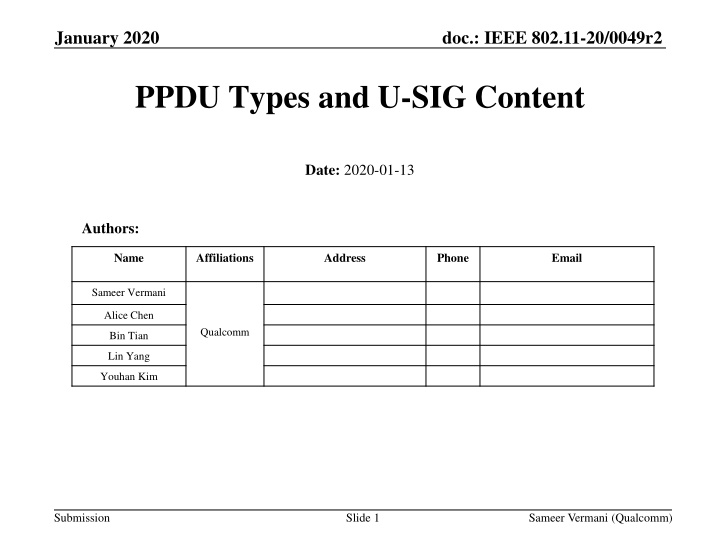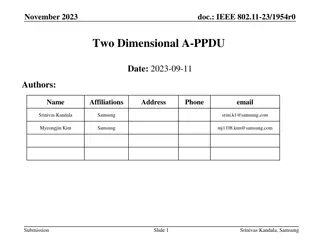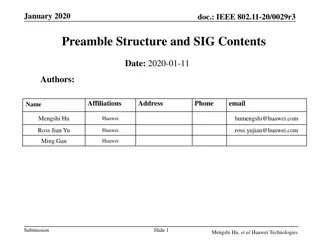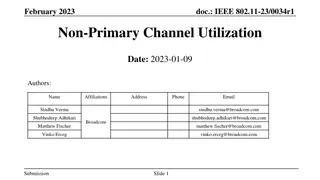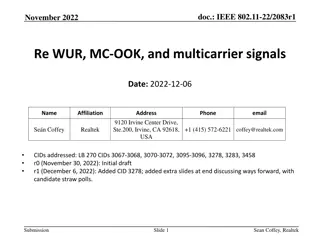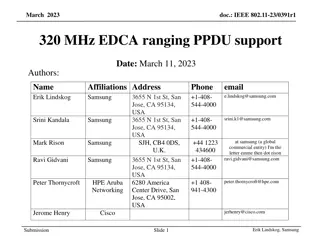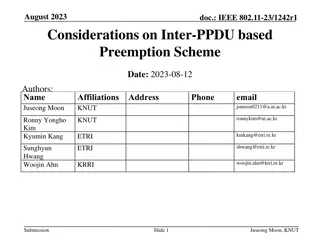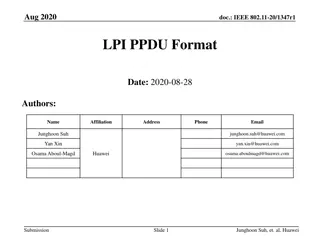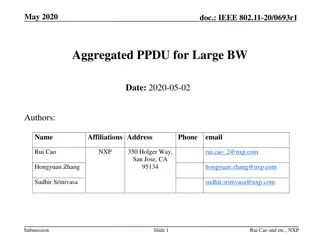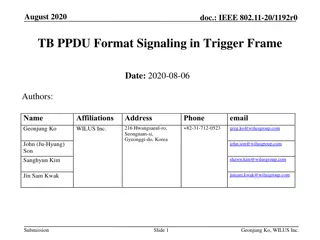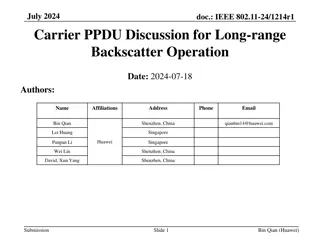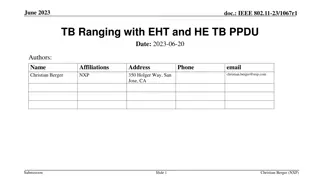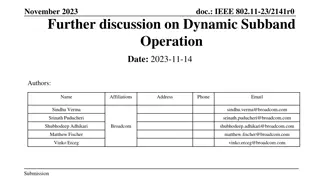IEEE 802.11-20/0049r2: PPDU Types and Bandwidth Information Update
These slides discuss the inclusion of bandwidth information in U-SIG fields for IEEE 802.11 networks. The focus is on enhancing spectrum occupancy details in a version-independent manner, allowing for future-proofing with potential higher bandwidths. Suggestions include incorporating a PPDU type field to differentiate among different PPDU types of WiFi amendments.
Download Presentation

Please find below an Image/Link to download the presentation.
The content on the website is provided AS IS for your information and personal use only. It may not be sold, licensed, or shared on other websites without obtaining consent from the author.If you encounter any issues during the download, it is possible that the publisher has removed the file from their server.
You are allowed to download the files provided on this website for personal or commercial use, subject to the condition that they are used lawfully. All files are the property of their respective owners.
The content on the website is provided AS IS for your information and personal use only. It may not be sold, licensed, or shared on other websites without obtaining consent from the author.
E N D
Presentation Transcript
doc.: IEEE 802.11-20/0049r2 January 2020 PPDU Types and U-SIG Content Date: 2020-01-13 Authors: Name Affiliations Address Phone Email Sameer Vermani Alice Chen Qualcomm Bin Tian Lin Yang Youhan Kim Submission Slide 1 Sameer Vermani (Qualcomm)
doc.: IEEE 802.11-20/0049r2 January 2020 Abstract In these slides we cover U-SIG Content Bandwidth information PPDU type field PPDU format design for EHT Also address whether we unify SU and MU PPDU formats or not Design of Compressed Modes for the MU PPDU format Submission Slide 2 Sameer Vermani (Qualcomm)
doc.: IEEE 802.11-20/0049r2 January 2020 Bandwidth Information in U-SIG So far, there is consensus on having the following version independent fields in U-SIG PHY version identifier: 3 bits UL/DL flag: 1 bit BSS color, number of bits TBD TXOP duration, number of bits TBD The fields in red tell us about the medium utilization of the current PPDU How long ? In what link direction? And which BSS is using it ? Natural to add bandwidth information to the above group of fields (as a version independent field) Tells us about the spectrum occupancy of the current PPDU Puncturing info maybe useful to add as well as that makes this information more precise Submission Slide 3 Sameer Vermani (Qualcomm)
doc.: IEEE 802.11-20/0049r2 January 2020 Bandwidth Information as Version Independent Intent of version independent fields is for future generations to have a more sophisticated coexistence Spectrum utilization information has cross-generational appeal Ability to understand this information precisely across PHY amendments is useful What if future amendments add higher bandwidths than 320MHz ? We can make the bandwidth field future proof by leaving un-used states Un-used states can have a specific meaning for EHT devices (e.g. >320MHz) Example on slide 17 in Appendix Can also be handled by expanding the BW field in a backwards compatible way in the future Submission Slide 4 Sameer Vermani (Qualcomm)
doc.: IEEE 802.11-20/0049r2 January 2020 PPDU Type in U-SIG The PHY version identifier field in the version independent section of U- SIG differentiates between WiFi amendments (11be/bf/bg ) We still need a field to differentiate among different PPDU types of a particular amendment No longer using L-SIG length for this Suggest to add a PPDU type field in U-SIG for this purpose Subsequent format of preamble can change depending on PPDU type 2-3 bits should be enough We would like PPDU type to be a version dependent field in U-SIG Every version of WiFi can have its own set of PPDU types Submission Slide 5 Sameer Vermani (Qualcomm)
doc.: IEEE 802.11-20/0049r2 January 2020 PPDU Types in EHT 11ax supports 4 PPDU types: TB, SU, ER-SU, MU EHT will support >=2 PPDU types TB is quite different from SU & MU, and should be an independent PPDU type SU/MU PPDU types may be unified Discussion in subsequent slides shows why unification is a good direction ER SU need is up for discussion Not covered in this slide deck Submission Slide 6 Sameer Vermani (Qualcomm)
doc.: IEEE 802.11-20/0049r2 January 2020 EHT TB PPDU Design For TB PPDU, a 2-symbol U-SIG, with no EHT-SIG is enough 52 bits in U-SIG are more than enough to accommodate all the version independent fields and version dependent fields Details in Appendix EHT-STF EHT-LTFs Data L-SIG RL SIG U-SIG L-STF L-LTF TB PPDU Format for EHT Submission Slide 7 Sameer Vermani (Qualcomm)
doc.: IEEE 802.11-20/0049r2 January 2020 Whether to unify SU/MU PPDU format or not? (1) If SU PPDU is a separate format, a 1 symbol EHT-SIG at MCS0 is still needed Around a total of >=47 bits need to carried in the U-SIG and EHT-SIG (Details in Appendix) 1 symbol Fixed MCS: rate , BPSK SU PPDU EHT- SIG L-SIG RL SIG U-SIG L-STF L-LTF (If separate from MU) The decision to merge SU and MU PPDU formats depends on the extra overhead of using the MU PPDU format while sending to a single user Variable MCS/length as indicated in U-SIG Not a symbol boundary SU PPDU EHT- SIG- common EHT- SIG-per- user L-SIG RL SIG U-SIG L-STF L-LTF (If combined with MU) Based on SIG field content, don t see a huge additional burden by sending the MU PPPDU to a single user Only a few redundant fields compared to using a separately optimized SU PPDU format (Details in appendix) Submission Slide 8 Sameer Vermani (Qualcomm)
doc.: IEEE 802.11-20/0049r2 January 2020 Whether to unify SU/MU PPDU format or not? (2) Even if there is some additional burden, the EHT-SIG in MU case can go at a higher MCS than MCS0 in majority of the cases The final additional overhead expected to be minimal for most cases Moreover, the SU puncturing and RU aggregation cases are likely to use the MU PPDU format Hence, we recommend unifying SU and MU PPDU formats Submission Slide 9 Sameer Vermani (Qualcomm)
doc.: IEEE 802.11-20/0049r2 January 2020 Special Cases of MU PPDU If we go with the SU/MU PPDU unification paradigm, EHT is expected to support the following cases of the MU PPDU Ones in red might have potential for compression of SIG field Submission Slide 10 Sameer Vermani (Qualcomm)
doc.: IEEE 802.11-20/0049r2 January 2020 Compressed Modes Design Proposed compressed modes for MU PPDU(assume unification with SU) are shown below Compression mode 1: Used for Full BW SU or Full BW MU-MIMO; RU allocation info in the common field is omitted Compression mode 2: Used for Punctured SU or Punctured MU-MIMO; RU allocation info in the common field is replaced by a punctured channel info with granularity of 20MHz Notes SU or MU-MIMO is indicated through the number of EHT-SIG symbols field which is interpreted as number of non-OFDMA users Value 0 indicates SU Similar to 11ax where the number of MU-MIMO users is indicated in this way SU will have only ONE EHT-SIG-per-user field of the non-MU-MIMO allocation format (even for puncturing mode) Submission Slide 11 Sameer Vermani (Qualcomm)
doc.: IEEE 802.11-20/0049r2 January 2020 Summary We proposed the following in these slides Bandwidth information as a version independent field PPDU type as a version dependent field No EHT-SIG for TB PPDU Format Unification of SU and MU PPDU Formats Two compressed modes to support SU and non-OFDMA MU- MIMO cases (with and w/o puncturing) Submission Slide 12 Sameer Vermani (Qualcomm)
doc.: IEEE 802.11-20/0049r2 January 2020 Straw-poll 1 Do you agree U-SIG will contain bandwidth information, carried as a version independent field? This information may also convey some puncturing information Number of bits is TBD Submission Slide 13 Sameer Vermani (Qualcomm)
doc.: IEEE 802.11-20/0049r2 January 2020 Straw-poll 2 Do you agree to add PPDU type as a version dependent field in U-SIG? Number of bits is TBD Submission Slide 14 Sameer Vermani (Qualcomm)
doc.: IEEE 802.11-20/0049r2 January 2020 Straw-poll 3 Do you agree that in EHT, SU and MU PPDU formats will be signaled using the same value of the PPDU type field? Submission Slide 15 Sameer Vermani (Qualcomm)
doc.: IEEE 802.11-20/0049r2 January 2020 Motion 1 Move to add the following to the SFD The U-SIG shall contain Bandwidth Information, carried as a version independent field. This field may also convey some puncturing information Number of bits for this field is TBD Submission Slide 16 Sameer Vermani (Qualcomm)
doc.: IEEE 802.11-20/0049r2 January 2020 Motion 2 Move to add the following to the SFD The U-SIG shall contain a PPDU type field, carried as a version dependent field. Number of bits for this field is TBD Submission Slide 17 Sameer Vermani (Qualcomm)
doc.: IEEE 802.11-20/0049r2 January 2020 Motion 3 Move to add the following to the SFD For 802.11be, the SU and MU PPDU formats shall be signaled using the same value of the PPDU type field. Submission Slide 18 Sameer Vermani (Qualcomm)
doc.: IEEE 802.11-20/0049r2 January 2020 Some more details about SIG contents APPENDIX Submission Slide 19 Sameer Vermani (Qualcomm)
doc.: IEEE 802.11-20/0049r2 January 2020 Example of a future-proof BW Field We can make the bandwidth information future proof by leaving un-used states (shown in red) EHT devices may be required to behave in a certain way when they see the field set to those states 3 bit field value (decimal) Meaning for EHT (in MHz) Meaning for EHT+ (in MHz) 0 20 20 1 40 40 2 80 80 3 160 160 4 240 240 5 320 320 6 >320 New bandwidth 1 7 >320 New bandwidth 2 Submission Slide 20 Sameer Vermani (Qualcomm)
doc.: IEEE 802.11-20/0049r2 January 2020 TB PPDU U-SIG Content U-SIG transmits total 52 bits, including Version independent fields: >=21 bits Version identifier (3 bits), UL/DL (1 bit), TXOP (7 bits), BSS color (6 bits) PPDU BW & Punctured channel info: >=4 bits Version dependent fields PPDU type: 2 bits Spatial re-use (SR) field(s): 4 bits (option 1: 1 SR field) or 8 bits (option 2: 2 SR fields) CRC: 4 bits Tail: 6 bits TBD: <=15 bits (option 1) or <=11 bits (option 2) Submission Slide 21 Sameer Vermani (Qualcomm)
doc.: IEEE 802.11-20/0049r2 January 2020 U-SIG & EHT-SIG content for separate EHT SU PPDU (1/2) For SU PPDU, a 2-symbol Pre-SIG, with a 1-symbol EHT-SIG is enough We propose the following fields in U-SIG and part of the common field in EHT-SIG Version independent fields: >=21 bits Version identifier (3 bits), UL/DL (1 bit), TXOP (7 bits), BSS color (6 bits) PPDU BW & Punctured channel info: >=4 bits Version dependent field(s) related to EHT-SIG field structure: 2 bits PPDU type: 2 bits Version dependent fields similar to MU PPDU: 17 bits Spatial reuse (4 bits), GI+LTF size (2 bits), Doppler (1 bit), LDPC extra symbol segment (1 bit), STBC (1 bit), Beam change (1 bit), Pre-FEC padding factor (2 bits), PE disambiguity (1 bit) The Number of EHT-LTF symbols and midamble periodicity field (4 bits) is replaced by NSTS and midamble periodicity field (4 bits) Submission Slide 22 Sameer Vermani (Qualcomm)
doc.: IEEE 802.11-20/0049r2 January 2020 U-SIG & EHT-SIG content for separate EHT SU PPDU (2/2) We propose the following fields in U-SIG and part of the common field in EHT-SIG (Cont d) Version dependent fields that are SU specific: 7 bits MCS: 4 bit DCM: 1 bit Coding: 1 bit Beamformed: 1 bit There are >=47 bits Fields of at most 42 bits will be in U-SIG, along with CRC (4 bits) and Tail (6 bits) Other fields will be in the 1-symbol EHT-SIG Submission Slide 23 Sameer Vermani (Qualcomm)
doc.: IEEE 802.11-20/0049r2 January 2020 More details on unification 26 additional bits need to be sent when an MU PPDU is used for single user purposes (vs a separate SU PPDU) EHT-SIG MCS (3 bits), EHT-SIG DCM (1 bit), number of EHT-SIG symbols (or number of non-OFDMA users) (5 bits), EHT-SIG compression (2 bits) STA ID field (11 bits) and NSTS field (4 bits) in the user-specific field Extra 26 bits for a unified SU/MU PPDU means >=73 bits total bits need to be sent for the SU case 42 can be carried in U-SIG and 31 need to be carried in EHT-SIG For EHT-SIG MCS> MCS0, one symbol may still be enough No extra overhead compared to separate SU PPDU for most cases Submission Slide 24 Sameer Vermani (Qualcomm)
